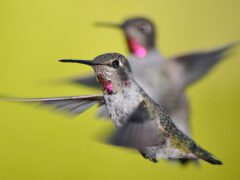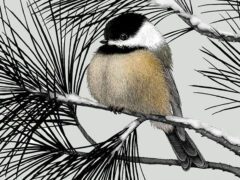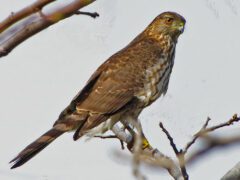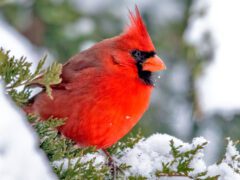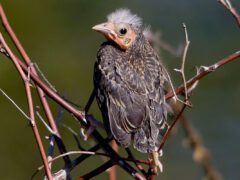The Four Keys to ID
- Size & Shape
A large, long-tailed songbird with a rather large head and a long, thick-based, sharply pointed bill.
Relative Size
Larger than a Baltimore Oriole, smaller than an American Robin.

 between sparrow and robin
between sparrow and robinMeasurements
- Both Sexes
- Length: 7.5-9.4 in (19-24 cm)
- Weight: 1.1-1.9 oz (31-53 g)
- Wingspan: 12.6 in (32 cm)
© Matthew Grube / Macaulay Library
- Color Pattern
Adults are bright yellow and black. The entire head and throat are black; the body is yellow, and the wings and tail are black (with white edges to some of the wing feathers). Males are only slightly more vivid in plumage than females. Juveniles have dark wings and tail, olive-yellow head, green back, and a duller yellow belly.
© Henry Burton / Macaulay Library - Behavior
Forages in dense cover and occasionally on the ground for insects and fruit. Also inserts the bill into vegetation to pry open gaps and expose insect larvae (known as “gaping”). Nests and often sings in areas concealed by dense vegetation. Sometimes visits backyard feeders.
- Habitat
Lives year-round in woodlands along streams, brushlands, and well-wooded wildlife refuges.
© Edgar Miceli / Macaulay Library
Regional Differences
Ornithologists recognize four subspecies, of which only the subspecies audubonii nests in the United States. Just south of this subspecies, graduacauda occurs. This subspecies lacks white edges in the black wings. Farther south, in western Mexico, the subspecies nayaritensis is notable in that males are much more brightly colored than females. In southern Mexico, dickeyae is sometimes treated as a separate species, Dickey’s Oriole, which is larger, more brightly colored, and has a heavier bill.





















